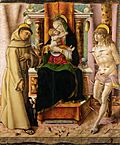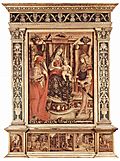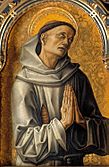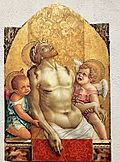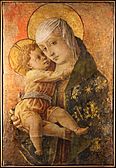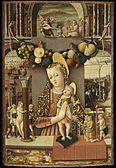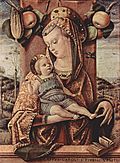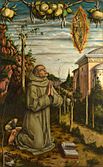Carlo Crivelli facts for kids
Quick facts for kids
Carlo Crivelli
|
|
|---|---|
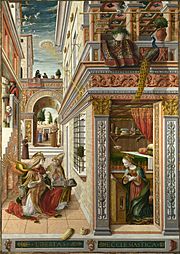
The Annunciation, with St. Emidius (1486)
National Gallery, London |
|
| Born |
Carlo Crivelli
c. 1430 |
| Died | c. 1495 (aged 64–65) |
| Nationality | Italian |
| Known for | Painting, tempera |
| Movement | Late Gothic/Renaissance |
Carlo Crivelli (born around 1430 in Venice, died around 1495 in Ascoli Piceno) was an Italian Renaissance painter. He had a unique style that blended older Gothic ideas with new Renaissance art. He spent his early years in the Veneto region of Italy. There, he learned from artists like the Vivarini family, Francesco Squarcione, and Andrea Mantegna.
After 1458, Crivelli moved away from Venice. He spent most of his career in the March of Ancona area of Italy. His art style was very different from other Venetian painters of his time, like Giovanni Bellini.
Contents
Carlo Crivelli's Early Life
Carlo Crivelli was born in Venice between 1430 and 1435. His family included other painters. He learned his art skills in Venice and Padua. We don't know many details about his early career.
It is thought that he might have studied with Jacobello del Fiore. He also trained at the school of the Vivarini family in Venice. Later, he moved to Padua. He is believed to have worked in the art studio of Francesco Squarcione there. In 1459, he left for Zadar in Dalmatia, which is now part of Croatia. At that time, it was a Venetian territory.
His Artistic Journey
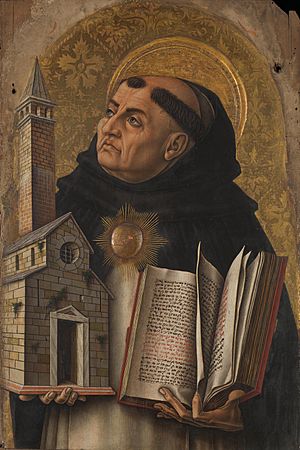
Carlo Crivelli signed his paintings with dates from 1468 to 1493. One of his earliest signed works is an altarpiece from 1468. It is in the church of San Silvestro at Massa Fermana. One of his last known works is The Dead Christ between St John, the Virgin and Mary Magdalene from 1493. This painting is now in Milan's Brera Gallery.
Even though Crivelli often signed his works as "Carlo Crivelli of Venice," he mostly worked in the March of Ancona region. He spent a lot of time in and around Ascoli Piceno. Today, only two of his paintings can be found in Venice. Both are in the church of San Sebastiano.
Crivelli preferred to paint using tempera paints. This type of paint uses egg yolk to bind the colors. He used tempera even though oil painting was becoming more popular. He also painted on wooden panels. Some of his paintings have since been moved to canvas. He often used shiny, gold backgrounds with decorative patterns. This shows his traditional style.
Many of his early polyptychs (altarpieces made of several panels) have been taken apart. Their individual panels are now in different museums. However, one complete altarpiece from Ascoli Piceno, dated 1473, still exists. It is in its original frame and location in the city's Cathedral.
Other artists who copied or were influenced by Crivelli's style are sometimes called Crivelleschi.
What Makes His Art Special?
Crivelli's art style was different from the realistic art that was popular in Florence at the time. His style kept the fancy, detailed look of International Gothic art. His city scenes look like jewels and are full of detailed symbols. He loved to paint green landscapes in the background.
You can often spot his paintings by his special use of fruits and flowers. He would often paint them hanging in decorative garlands. This was also a common feature in the studio of Francesco Squarcione in Padua, where Crivelli might have worked.
His paintings have clear lines, similar to artists from the Umbria region. Crivelli was a very unique painter. Unlike his contemporary, Giovanni Bellini, Crivelli's works are not "soft." Instead, they have clear and sharp outlines with lots of attention to small details. He was also good at trompe-l'œil. This is a French term meaning "to trick the eye." It makes flat paintings look like they have real, 3D objects. He would even add raised objects, like jewels or armor, using a material called gesso on the panel.

Crivelli's art was mostly religious. He was asked to paint by groups like the Franciscans and Dominicans in Ascoli. His paintings often showed the Madonna and Child (Mary and baby Jesus). He also painted Pietà scenes, which show Mary mourning over the dead body of Jesus. He continued to paint polyptychs, even when they were going out of style.
His works often showed strong emotions and detailed scenes of suffering. This helped his patrons connect with the religious stories. Some critics have called his paintings "grotesque" because of their very realistic and sometimes intense details. However, his work was very popular and he received many important requests for paintings.
Carlo Crivelli passed away in the Marche region, probably in Ascoli Piceno, around 1495. Vittorio Crivelli was his younger brother and sometimes worked with him. Pietro Alemanno, a painter from Germany or Austria, was his student and helper. Donato Crivelli, another painter, might have been related to Carlo.
How Was He Remembered?
After Carlo Crivelli died, his work became less popular. Giorgio Vasari, a famous writer about artists, didn't even mention him in his book Lives of the Most Excellent Painters, Sculptors, and Architects. This book mostly focused on artists from Florence.
However, Crivelli's art became popular again in the United Kingdom during the time of the Pre-Raphaelite painters. Artists like Edward Burne-Jones admired his work. His fame faded again after that movement. But recently, new writings about his art and a new display of his works at the National Gallery, London, have brought him back into the spotlight.
The writer Susan Sontag mentioned Crivelli in her 1992 book Notes on "Camp". She wrote that his paintings, with their real jewels and trompe-l'œil insects, were an example of "Camp" style.
Famous Paintings by Crivelli
- 1472 Altarpiece, parts of which are now in different galleries in the United States and Europe.
- Adoration of the Shepherds, in the Musée des Beaux-Arts de Strasbourg.
- The Annunciation, with Saint Emidius, 1486, in the National Gallery, London. This is possibly his most famous painting.
- An Apostle, around 1471–73, in the Metropolitan Museum of Art, New York.
- Ascoli Piceno Altarpiece (also called Saint Emidius Altarpiece), 1472–73, in the Cathedral of Saint Emidius, Ascoli Piceno. This is the only altarpiece that still exists completely in its original frame and location.
- Beato Ferretti, 1489, in the National Gallery, London.
- Dead Christ, in the Vatican Gallery.
- Enthroned Madonna, St. Jerome and St. Sebastian, 1490.
- The Immaculate Conception, 1492.
- Lamentation over the Dead Christ, 1485, in the Museum of Fine Arts, Boston.
- Madonna and Child, 1480, in the Metropolitan Museum of Art, New York.
- Madonna and Child, 1460, in Verona.
- Madonna and Child, 1480–1486, in Ancona.
- Madonna and Child, in the Church of San Giacomo Maggiore in Massignano.
- Madonna and Child Enthroned, 1472, in the Metropolitan Museum of Art, New York.
- Madonna and Child with Saints, 1490.
- Madonna and Saints, 1491, in Berlin.
- Madonna of the Candle, in the Brera of Milan.
- Madonna of Poggio Bretta, around 1472, in the Diocesan Museum of Ascoli Piceno.
- Madonna with child and saints, in Monte San Martino in Marche.
- Mary Magdalene, 1480, in the Rijksmuseum, Amsterdam.
- Pietà, 1476, in the Metropolitan Museum of Art, New York.
- Saint Dominic, 1472, in the Metropolitan Museum of Art, New York.
- Saint Francis with the Blood of Christ, 1480-1486.
- Saint George Slaying the Dragon, 1470.
- Saint James Major, part of an altarpiece, 1472, in the Brooklyn Museum.
- Saint Stephen from the Demidoff Altarpiece, 1476, in the National Gallery, London.
- San Giacomo, 1472.
- St Thomas Aquinas, 1476, in the National Gallery, London.
- Virgin and Child with Saints Francis and Sebastian, 1491.
- Virgin Annunciate, 1482, in Frankfurt.
Another important painting is in San Francesco di Matelica.
Gallery of paintings
-
Saint George, 1472
-
Saint Catherine, 1476
-
Madonna with Child, c.1470, Macerata
-
Madonna and Child, 1460, Verona
-
Madonna and Child, 1480, Metropolitan Museum of Art, New York City
-
Madonna and Child, 1480–1486, Ancona
-
Beato Ferretti (The Vision of the Blessed Gabriele), c. 1489, National Gallery
See also
 In Spanish: Carlo Crivelli para niños
In Spanish: Carlo Crivelli para niños
- Crivelli carpet
- Huldschinsky Madonna (painting)







